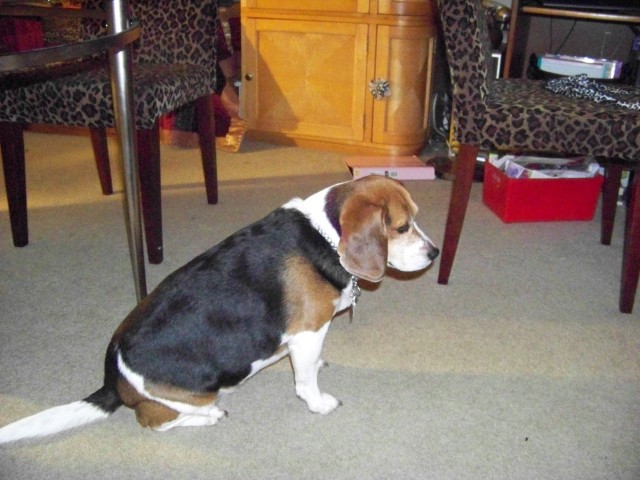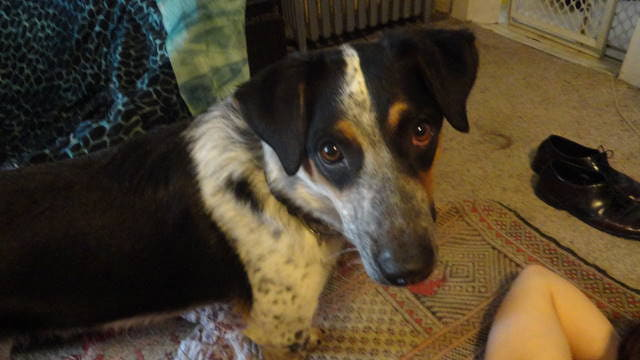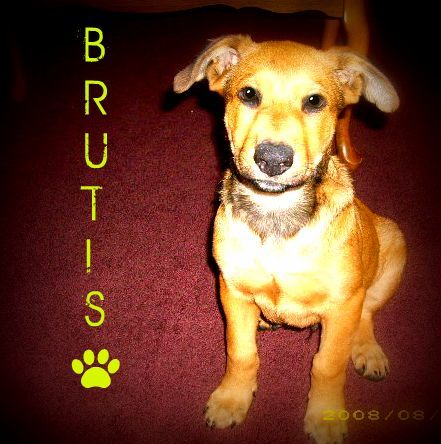QuestionI have a 2 year old yellow lab. I try to get him to play ball and he acts like he is afraid of it. He will go to it and put it in his mouth and then drop it. Do you have any helpful tricks that I can use to teach him to play ball?
Thank you,
Kent
AnswerHi Kent,
Basically: Take it slow and make it fun!
Because you say that he seems "afraid of it," he is probably experiencing anxiety due to your frustration. So the first step will focus on reducing his anxiety (and your frustration). As with any training, if you find yourself becoming frustrated, STOP. If possible, ask your dog to do something so simple that you know he will be successful at it. Give him lots of praise and end the session. After you calm down, reflect back on when things fell apart. Common mistakes: 1) expectations were too high (break it down and reward small steps toward your goal), 2) session was too long (15 min./day is ideal and can be broken into 5 min. sessions; more is not better and usually is worse), or 3) you are not communicating effectively (watch your timing, body language, cues, etc.).
OK, here's a brief outline on teaching him to play ball. To give you an idea of the time frame, we followed a similar program with one of our dogs and it took 4 months (we spent ~5 min./day) for him to return with a Frisbee.
STEP 1: Don't expect him to love playing ball at first. You might need to start out by simply playing with the ball in front of him to get him interested; don't even offer the ball to him though. You can also get him to associate the ball with "good" things by placing it in or next to his food bowl at meal times.
STEP 2: When he begins to show an interest in the ball, you can encourage him to take it in his mouth. When he does and the ball is in his mouth, say "Take it" and give lots of praise and a tiny (fingernail sized) food treat if he's food motivated as most labs are. It's OK if he drops the ball immediately. After a couple of times of saying "Take it" after the ball is in his mouth, begin to say "Take it" before it is in his mouth. Say "Drop it" when he releases the ball to introduce a cue for this, too.
STEP 3: Build on the time he holds the ball in his mouth by giving praise and treats only when he holds the ball for 3 seconds, 5 seconds, or more. The keys are to increase the amount of time he holds it slowly (think days here) and keep sessions short (5 min. or less). Continue with "Drop it."
STEP 4: Introduce picking the ball from the ground by placing the ball at your feet and encouraging him to "Take it." Give praise and treats for small steps here. You may have to start by praising when he touchs the ball and build up from there. When he does this reliably, move the ball a foot away and begin the sequence again. By the way, you can use "Get it," "Fetch," or any other verbal cue you desire in place of "Take it," just be consistent.
STEP 5: When he will go to and pick up the ball from a distance, even a short distance, encourage him to return to you by squatting down and/or moving away from him. At this point, you can introduce "Bring it" or a similar cue. Always keep in mind the concept of building on small successes. If he picks up the ball and takes one step toward you, give praise and treats. Then give praise and treats only when he takes 2 or more steps, etc.
For more details on teaching Fetch and other tricks, check out our class handouts for Tricks and Dog Sports classes that we teach at http://downstay.com/handouts.php
Although any dog can be taught to perform almost any trick (there are some physical limitations), you will find that your dog performs some tricks better than others. If you find that your dog still doesn't like playing ball after a few months of effort, try to find something else that you and your dog both enjoy (the class handouts might give you some new ideas).
Take care,
Chris & Beth
(with help from Brandy, Asia, Brodie, Fenris, & Loki)
downstay.com

 Crystal the beagle
Question
Crystal
Crystal is 8 1/2 years old,she is a be
Crystal the beagle
Question
Crystal
Crystal is 8 1/2 years old,she is a be
 A doting mother in need of help!
Question
Chewy
In the past year I got a cattle d
A doting mother in need of help!
Question
Chewy
In the past year I got a cattle d
 Ponter cross aggression
Question
Ollie
I have an 8 y/o pointer cross lurcher (w
Ponter cross aggression
Question
Ollie
I have an 8 y/o pointer cross lurcher (w
 dog training.
Question
Brutis
I have a 6 month old german shepherd/la
dog training.
Question
Brutis
I have a 6 month old german shepherd/la
 Dog jumps on counters, Refrigerator,cabinet tops when Im not home
Question
Bell
Hello,
I dont even know where to
Dog jumps on counters, Refrigerator,cabinet tops when Im not home
Question
Bell
Hello,
I dont even know where to